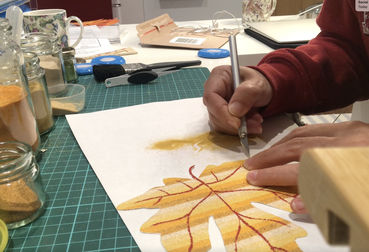Discovering Sand ArtSand art, painting with sand. This is the first sand art drawing that I painted with my daughter's help in a toddler's party the day that I discovered Sand Art. This is the first sand art drawing that I painted with my daughter's help in a toddler's party the day that I discovered Sand Art. I discovered sand art at a toddler party. https://sales.kidsbeehappy.com/ The children were given a drawing on yellow sticky paper where the outlines of the picture were already partially cut out. Peeling off sections from the surface of the sticky paper, the children could then apply different colors of sand to each area exposed. Basically, the same stick-on peel-off method that I was using to stencil on my tables (see painted-tables.html) This process was so satisfying in a sensory way, feeling the texture of the sand and the velvety surface of the drawing, that I needed to explore it more! I started experimenting using sand on paper with glue but it didn’t give the same smooth finish and clear outline. The glue would leave trails and an uneven finish. The sticky paper was crucial! So I bought A4 sticky printer paper (without cutout). This worked but the paper was too thin. It needed to be glued to a card with a special adhesive to prevent a lumpy surface. For the colored sand, I searched the web for a broad palette of interesting colors. There is a method of coloring sand with finely grated pastel colors but this type of sand leaves a residue and it is difficult to obtain intense hues with this method. Shopping around, I discovered that the wedding industry uses colored sand for decorative purposes. From these sources, I bought sand in small quantities of 0.5mm and 0.2mm.  Acer leaf painted with sand art. Acer leaf painted with sand art. There is little control over the sand when it is applied to the paper. For this reason, it is necessary to peel off the sticky paper slowly, bit by bit, to control the area you want to color. Otherwise the colors may mix. I drew on the prepared paper and cut off the surface, piece by piece, according to each color that I chose to use. In this way, the sand sticks to the uncovered area. As with the table's stencils, it is important to control the depth of the cut that the knife makes otherwise you will cut right through the paper. The “View of York Minster” is my first artwork using this technique. I wanted to give the impression that the viewer is looking through a window and so I chose “a window frame”. I also assumed it would be easy to work within the sections of the frame.
0 Comments
Leave a Reply. |

